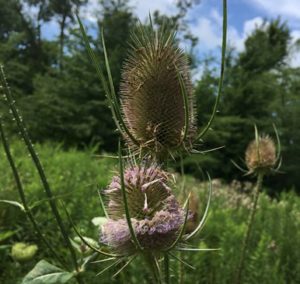 By ROBIN MAYES, Gallant Farm educator
By ROBIN MAYES, Gallant Farm educator
As I run the rural roads of Delaware County this time of year, my eyes are often distracted by the splash of color amidst a sea of green grasses in the roadside ditches. As cars pass me, hurriedly zipping from here to there, the passengers may simply dismiss the bright botanical blurs as nuisance “weeds” but there is much more to these ditch-dwellers.
One of the more noticeable flowers is the sky-blue daisy-like flowers of the chicory plant (Cichorium intybus). Sometimes called ‘blue devils’ or ‘ragged sailors’ the chicory is native to Eurasia, but was brought to the New World where it became widely naturalized. Coffeeweed is another nickname for the plant and hints at one of its uses. Our Colonial ancestors discovered that the root has health benefits such as anti-inflammatory properties, helps manage osteoarthritis and even may help protect the liver, to name a few. People roasted and ground the chicory root to make a good coffee substitute or additive. Today, some craft beer brewers add the roasted root to add flavor to stouts. Thanks to the high levels of tannin in chicory, some farmers even include it in the diet of their sheep to help avoid internal parasites.
My eyes are also drawn to the smaller and slightly less noticeable pink or magenta blooms of the red clover (Trifolium pretense). This plant was also imported by European settlers to the New World. Thought to be a blood purifier and an aid in cardiovascular health, the dried blossoms of red clover were highly valued. Red clover tea has also been thought to ease the pain of childbirth and there are claims that it may even have anti-cancer properties. Red clover is also highly prized on the farm as a nutritious livestock fodder, as well as an important nitrogen-fixer for soil.
In my opinion, the king of the roadside beauties would have to be teasel (Dipsacus fullonum). The plant is easily recognized by its tall stature, prickly leaves and stems, and the large spiky, porcupine-like seed heads with a whorl of spiny bracts at the base. Delicate pale purple flowers can be observed circling the ovoid seed heads early in the season. Also a naturalized transplant, teasel came here via the early settlers. Widely used in textile processing, the spiky seed heads provided a natural “comb” for cleaning and raising the nap of fabrics, or “tease-ing” the fibers – hence its name. The seed heads of teasel are also an important seed source for some wintering birds.
So the next time you see me on the road running this summer and I look distracted by something on the side of the road, I probably found another colorful roadside flower to admire.
If you would like to see more late blooming summer wildflowers, visit the prairies at Gallant Woods Park, Blues Creek Park or Deer Haven Park.






